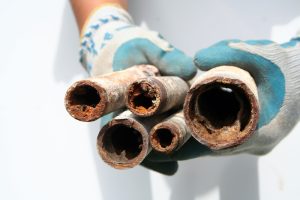Is your house brand-new, built just for you? If not, you probably don’t know everything about your home’s plumbing system. You might not be aware of the wide range of materials that have been used for plumbing pipes when your home was built. So, what are your pipes made of? And should you be concerned about it? Let’s dive into the depths of plumbing history.
Ancient Plumbing
In America, indoor plumbing may seem relatively new. It wasn’t until about a hundred years ago that most homes had proper indoor plumbing systems that we recognize today. But long ago, many cultures around the world—including China, ancient Egypt, and the Roman Empire—had very impressive plumbing.
About 2,300 years ago, Romans began to develop a remarkable system: aqueducts to channel water into cities. The most wealthy people of this culture even had water piped directly into their homes! Unfortunately, their pipes were made of lead, which is highly toxic.
A little further back, about 4,000 years ago, there was a water pipe system in China that avoided this toxicity problem, but it had issues of its own. While the sewer and drainage pipes were made from terracotta, an earthen clay, the freshwater pipes were made of hollow reeds, which don’t last very long.
The plumbing that stretches back to the earliest times belonged to the people of Egypt and India. Some of their systems date back 6,000 years! Furthermore, they used a material that’s still considered top-notch today: copper.
Modern Plumbing
In the US, we have used many different plumbing materials in just the last hundred years. Sewer pipes were often made of earthen clay, like those in ancient China, and then of cast iron before plastic options became available. And water lines have undergone many changes.
Unfortunately, lead pipes were used for decades. Even after the Safe Drinking Water Act banned the use of lead pipes in new plumbing work in 1974, lead solder was still used to connect pipes until as late as 1986! If your home isn’t newer than that, it’s entirely possible that you have some lead in your plumbing.
Plastic replacements used a wide array of polymers, and some were better than others. One type, called Kitec, is particularly at risk for leaks and burst water lines and was still being produced as recently as 2007. Today’s plastic options, such as PVC and PEX, are much more reliable. And, like the Egyptians and Indians, we are still using copper.
Plumbing Safety
The best thing you can do to improve your water quality is to make an appointment for a plumbing inspection. Someone with top-notch training and expertise can assess your plumbing in Cedar Grove, NJ. Any old materials, corroded pipes, loose connections, or sneaky leaks can be found and remedied. And you can rest easy, knowing your plumbing isn’t behind the times.
Contact MarGo Plumbing Heating Cooling Inc. today to schedule an appointment or ask any questions about your plumbing system!

